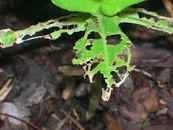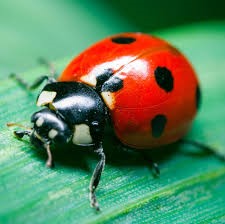Flying and Crawling Garden Pests
Japanese beetles were first found in the United States in 1916, after being accidentally introduced into New Jersey.
Until that time, this insect was restricted to Japan where it is not a major pest. This irridescent pest is considered to be an invasive species.

Japanese Beetle
Japanese beetles were first discovered in Minnesota in 1968. At first, only a few beetles were found but by 2001, they occurred in much higher numbers. In one year, the Minnesota Department of Agriculture (MDA) trapped more than one million beetles. Since then, Japanese beetle numbers have fluctuated from year to year.

Japanese Beetle
Japanese beetles can seriously damage a variety of flowers, trees and shrubs, fruits and vegetables, field crops and turf. Adults feed on more than 300 plant species, whereas the grubs feed mainly on the roots of grasses.
Managing adult Japanese beetles
- Japanese beetles can be very abundant in some years and less in others.
- Japanese beetles are not the end of the world. There are many ways to deal with them.
- In most cases, Japanese beetle damage is cosmetic only and will not kill plants.
Managing Japanese Beetles
Look for beetles in your yard and garden starting in late June and early July. Physically removing beetles works effectively practice for smaller landscapes or a few plants, when only small numbers of Japanese beetles are present. Handpick or knock the beetles into a bucket of soapy water to kill them. The best time to use this management method is early in the morning or late in the day when the beetles are sluggish.
Fine netting can deter these pests but should not be used on plants in bloom that require pollination like fruits, as this will prevent pollinators from reaching them.
DO NOT USE TRAPS!!! While traps can collect an impressive number of beetles, research at the University of Kentucky has demonstrated that more beetles fly toward the traps than are caught. This usually results in more damage to nearby gardens and landscape plants than would have happened if no traps were present.
Controlling Japanese beetle grubs will probably not reduce the number of beetles on your plants. Beetles emerging from non-treated grass areas can fly a considerable distance to preferred adult food plants. Treating white grubs will only protect lawns from damage.
SLUGS
Slugs are one of the most common garden pests, though unlike most other leaf-munching critters you find in your garden, they aren’t insects. Instead, slugs are land-dwelling mollusks that are more closely related to clams than beetles or caterpillars. Facing a slug infestation is serious business, filled with slime trails, damaged leaves, and missing seedlings. Figuring out how to get rid of slugs in the garden without turning to harsh synthetic chemical slug baits, is a task ripe with old wives’ tales and useless homemade remedies. The truth is that effective organic slug control is both manageable and affordable, when you’re armed with good tips and information.
Let’s face it, slugs are slimy and icky! Who really wants to pick them up or look at these disgusting little pests? Because they lack the protection of a shell, slugs tend to feed primarily at night or on rainy days, when they’re protected from the sun. During the day, they tend to hide under rocks or in other dark, moist locations.
Garden slug control can be difficult because many times the problem is misdiagnosed and the damage is blamed on another garden pest. Since slugs feed primarily at night, you usually can’t find the culprit when you search the garden during the day. That being said, you might choose to spray the plant with a general insecticide to kill the bug, which is useless, of course, against a mollusk like a slug. Going out at night and picking slimy creatures off of plants is not most people’s idea of a fun night out.
If you really want to know how to get rid of slugs in the garden, you first have to learn how to identify the damage they cause.
Slug prevention techniques:
- Avoid using loose mulches where slugs are prevalent. Skip straw, hay, and shredded wood mulches and opt for compost or leaf mold instead.
- Avoid watering the garden late in the day. Since slugs (and their eggs) thrive in wet conditions, always water in the morning so the garden dries by nightfall.
- Switch from overhead irrigation to drip irrigation which targets water at the root zone and keeps plant foliage dry.
- Plant resistant plants. Slugs dislike plants with heavily fragranced foliage, like many common herbs. They also dislike plants with fuzzy or furry foliage.
- Slugs are a favorite food of many different predators. Encourage birds, snakes, lizards, toads, frogs, ground beetles, and other natural predators to make a home in your garden.

Slug Damage

Slug Beer Trap
You know I had to mention everyone’s favorite/least favorite slug control: beer-baited traps. Yes, no list of tips on how to get rid of slugs in the garden is complete without a mention of beer traps. They are baited with beer (non-alcoholic works best). The yeast in the beer attracts slugs who then fall in and drown. It works, but it’s also incredibly gross. In order to prevent a festering pile of slug corpse-infused beer, be sure to empty and re-bait the traps daily.
There is the option of slug baits, but be careful small amounts (just a teaspoon or two) ingested by a small dog can kill them.
Diatomaceous earth has been touted as a great slug control. It’s a fine powder that is very sharp microscopically and the edges easily cut through slug skin and desiccate them as they crawl over it. Unfortunately, it needs to be reapplied after every rain or heavy dew.
A hearty sprinkle of salt, placed directly on a slug’s body, may kill a slug, but there’s a good chance it will merely shed its slime layer along with the salt and carry on as usual. It may not always work, but keep you salt shaker in your pocket for those tasty tomatoes!
And lastly, sharp-edged items, such as sweet gum seed pods, crushed eggshells, and dried coffee grounds have all been touted as great slug deterrents. I respectfully disagree and so do several studies, but give it a try if you think it will help.
APHIDS
Aphids feed on soft stems, branches, buds and fruit, preferring tender new. They pierce the stems and suck the nutrient-rich sap from the plant, leaving behind curled or yellowed leaves, deformed flowers, or damaged fruit. Most aphids feed on a wide variety of plants, although some species are specific to certain types of plants.
Aphids don’t like to dine alone, and can usually be found feeding in large groups. Think of a large Indian wedding. Depending on the level of infestation, they can cause serious damage to individual plants or even entire crops. Aphids produce multiple generations in one year and infestations can quickly get out of hand. Treating them early, before they have a chance to reproduce, greatly helps in keeping their numbers down.

Aphids on Rose
Managing Aphids
Water: Spray aphids off of plants with a strong stream of water from a garden hose. This method is most effective early on in the season before an infestation has fully taken hold. It may not be a good choice for younger or more delicate plants, but it works well on plants where you can use higher water pressure.
Remove by hand: Put on some garden gloves and knock them off of stems, leaves, flower buds, or wherever you see them into a bucket of soapy water to kill them. You can also cut or prune off the affected areas and drop them into the bucket
Natural and Organic Sprays
Soap and water: Make a homemade aphid spray by mixing a few tablespoons of a pure liquid soap (such as castile) in a small bucket of water. (Avoid using detergents or products with degreasers or moisturizers.) Apply with a spray bottle directly on aphids and the affected parts of the plant, making sure to soak the undersides of leaves where eggs and larvae like to hide. The soap dissolves the protective outer layer of aphids and other soft-bodied insects, eventually killing them. It doesn’t harm birds or hard-bodied beneficial insects like lacewings, ladybugs or pollinating bees. You can also purchase ready-to-use insecticidal soaps online or at a local nursery.
Neem oil: The organic compounds in neem oil act as a repellent for aphids and other insects, including mealybugs, cabbage worms, beetles, leafminers, ants and various types of caterpillars. However, it may repel beneficial insects, so use caution when and where they are present. Follow package instructions for diluting the oil in water or use a ready-to-use neem oil spray, and spray the affected areas. Neem oil is also good for controlling different types of fungus.
Essential oils: Create your own spray mixture with essential oils. Use 4 to 5 drops of each: peppermint, clove, rosemary and thyme, and mix with water in a small spray bottle. Spray on affected plants to target adult aphids, as well as aphid larvae and eggs.
Natural Predators
Bugs:
Lady beetles: Adult lady beetles (ladybugs) don’t eat nearly as many aphids as they do in their larval stage, which is why many people are disappointed with the lack of control they see after releasing purchased live ladybugs into their garden. There needs to be a large enough aphid population to keep the ladybugs fed long enough to mate and lay eggs — because it’s the larvae that eat the most aphids. Ladybug larvae don’t look at all like the adults we’re so familiar with, so identification is important. Live ladybugs can be purchased online or at your local nursery

Lady Bug
Tips for better results:
- Lightly mist plants before releasing to encourage them to stop for a drink as they are probably dehydrated.
- Release them in cooler times of the day, early morning or evening.
- Repeat applications are needed, as most will fly away within a few days.
- Green lacewings: As with ladybugs, green lacewing larvae do the work of controlling aphids. Green lacewing eggs can also be purchased online and sometimes at a local nursery.
Birds:
Provide houses for bug-eating birds, like wrens and chickadees, to live in and they’ll repay you by helping keep the insect population under control. Grow small trees and shrubs where they can take cover and build their own nests.
Sources: Savvy Gardening
University of Minnesota
Garden Design






